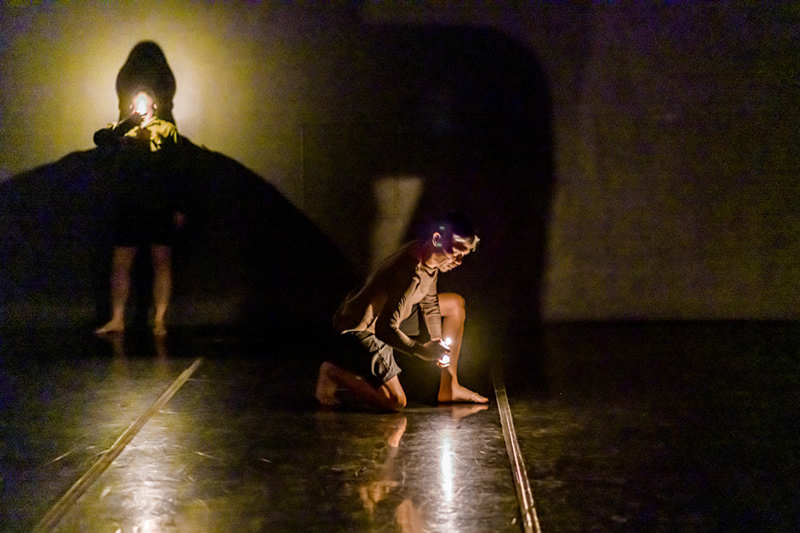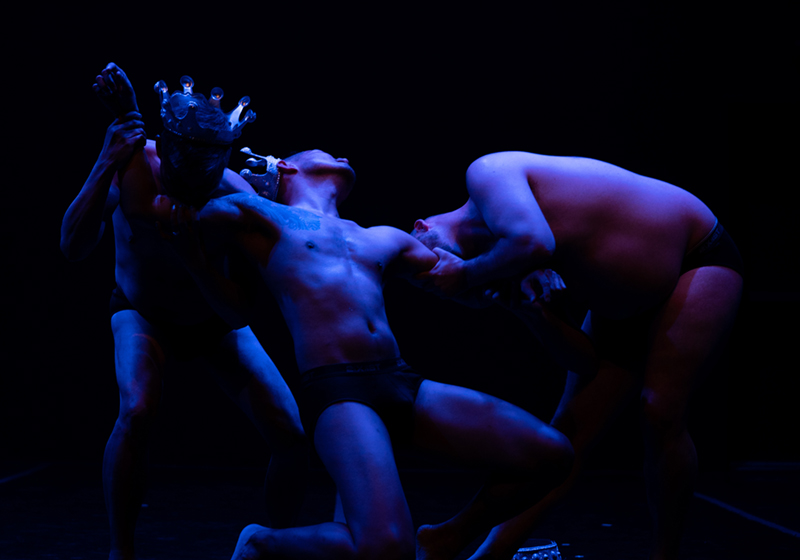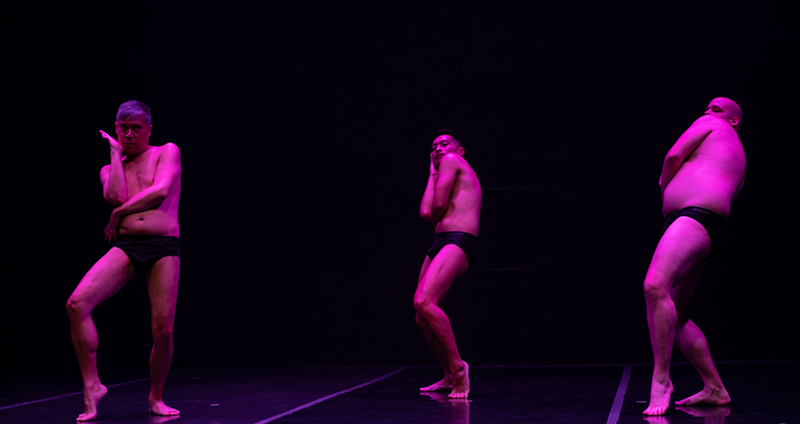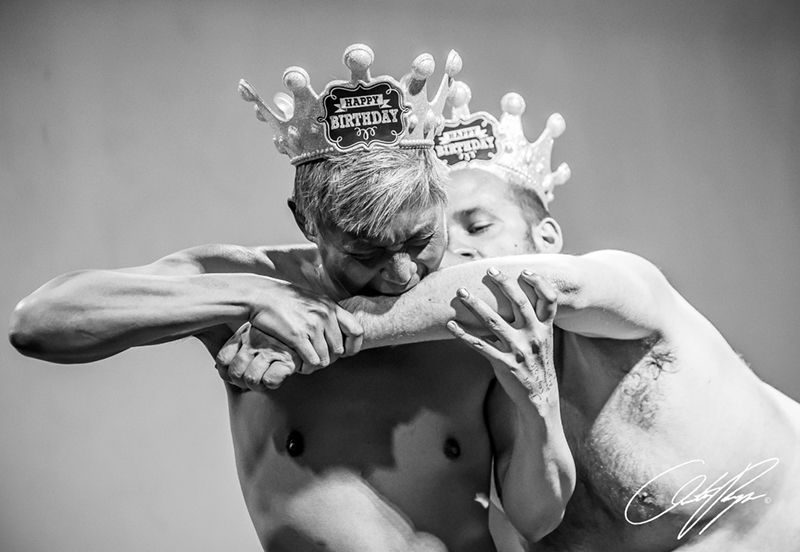Beyond Checking the Boxes
An Interview with Jesse Bie
BY EMMALY WIEDERHOLT
Jesse Bie is the director of San Francisco’s STEAMROLLER Dance Company, which has featured queer and Asian American perspectives since 1996. Here, Jesse reflects on his career and how queer and POC representation has evolved, as well as how his role as director of AIRSpace at SAFEhouse Arts allows him to educate younger dance artists on those who came before them.
Photo by Kyle Adler
~~
Can you share a little about your own dance history – what kinds of performance practices and in what contexts shaped who you are today?
I came into dance fairly late, about age 19. When I started college, I was a theater major, and the department made us take dance classes. When it became clear at the time that I would never get a job as an actor because I was Asian, I refocused on dance, specifically jazz, ballet and modern. I get a lot of my performance style from my early theater/jazz dance training. I took to it like a duck to water and decided to get a degree from San Diego State, where my training was pretty standard modern dance, rooted in Humphrey/Limón technique, which I still love.
While I was there, a company from San Francisco was in town, called High Risk Group, and I took their workshop. They were a queer dance company doing work around HIV/AIDS, which really spoke to me. It was a revelation to share lived experience through dance. They also impressed me with their DIY aesthetic, doing things on a shoestring budget, and dancing in the street. That was another revelation: You mean I don’t have to only dance in studios?
A spot opened in the company because one of the dancers was injured. They asked me to join. It was my dream, moving to the big city and getting to dance. I decided I didn’t need my degree. Looking back, maybe I should have made provisions to finish. I dropped everything and moved to San Francisco in 1992. I was all of 21.
The company had a live/workspace in the Mission, so I moved there for a few months. It was quite an experience, not having any work-life separation. I slept in the space we performed and rehearsed in.
After that, I started dancing with Scott Wells, who furthered my interest in improvisation and contact. Moving in contact with another body became the basis for how I make work. I really dislike solo work. Everything I do is collaborative. After 30 years of dancing in my body, I need the information and perspective that other bodies bring.
I also started working with Stephen Pelton and Kulintang Arts. Alleluia Panis, the director of Kulintang Arts, became a mentor to me and introduced me to work that drew from my heritage but I had never worked in. That still influences my work to this day.
Photo by Robbie Sweeney
How did STEAMROLLER Dance Company get started?
STEAMROLLER started in 1994 after I’d been dancing in a few different companies and watching other people make their art. My husband at the time was a visual artist and wanted to create a multimedia work. He asked me to collaborate. We had friends in common we pulled into the project as well, and we created an evening-length work about HIV/AIDS. After the project, everyone went their own way.
Two years later, I had an opportunity to present work, so I resurrected the piece. I poached dancers from other companies I was working with, asking if they’d be interested in this project. They all said yes, which was fantastic. There was a festival called Bay Area Dance Series and we got in right off the bat. It was supposed to be a shared bill with a choreographer from the UK, but we got a notification about a week before saying the other choreographer was unavailable and asking us to fill the evening. We pooled our resources and pulled it off. That was our first formal show. After that, we were hot. People were asking us to perform here and there. We started applying for things and getting them. That got the ball rolling.
STEAMROLLER has morphed several times. Maybe five years in, when my husband and I got divorced, no one wanted to stay around because of the drama, except for one dancer. She helped me rebuild the company, which transformed from being part Asian to entirely Asian. It was a dream to have all people of color and mostly queer. That continued for maybe four years and then people drifted away again.
I had a health crisis in 2009, partly due to substance abuse issues which I addressed in a work I did in 2010 after I got out of a stint in the hospital due to complications from HIV. Here is a clip of the work entitled Big Homo Love Explosion, which I premiered as part of ODC’s House Special Program.
I was incredibly stressed and burned out. I stopped dancing for about seven years. Since then, I haven’t had a stable company and have been working as a pick-up company. Fortunately, I have enough connections in the community that I can call on dancers, some former and some brand new, for different projects.
I’m still touched when I have random encounters and people tell me they loved one of our older works. I’m surprised they still remember that far back. It’s very moving.
How has your work changed since the company was founded in the mid-90s?
It’s still a collaborative process, but I’ve fully stepped into the role of director now. I drive everything in terms of what we’re going to work on. That said, I really need people to push and pull; I don’t want automatons. I need texture and grit from dancers. I always give them complete freedom to say no. I don’t need someone who will do everything I ask.
Content wise, I’ve always done commentary on what is relevant. It tends to be queer, but it’s shifted with the makeup of the company. Some things are appropriate to explore depending on who I work with. I don’t like to “cast.” That said, I do like to include people of color in my work, especially if they’re Asian. My racial and queer identity figures prominently in my choreography.
It’s also changed in terms of the timeline. I have to work a lot faster now. It’s not preferable, but that’s the nature of the field. It’s also become harder to negotiate rehearsals in terms of dancers needing three jobs. I used to have more access to dancers and flexibility with rehearsals. Now it’s like, “I have space at 8 a.m., I’m sorry but I’ll get you coffee before rehearsal…” It’s been a struggle.
Access in general is difficult, both to space, funding and opportunities. It’s more competitive than ever. The Bay Area is a different landscape than when I moved here. I find myself as an elder in the community, which is a role I’ve been resistant to in the past. It’s amazing how many younger artists there are each year and I struggle to keep up with the constant changes. But now I’m leaning into it the older I get.
Speaking generally, what is your choreographic process when you go to make a new work?
Rehearsal usually starts with 30 minutes of conversation on a theme or idea I have. We’ll discuss what the dancers’ perspectives are or their take on the theme, and then from there we’ll start a process. We might create material from a free write, for example, or we might use chance and accumulation, where each dancer is asked to contribute movement to create a phrase. Play figures a lot into my rehearsal process. If the dancers are goofing off, it might end up in the piece. I draw a lot from their personalities and what they bring to the process. Usually I work in trios and duets, never more than five.
Is there a specific piece you’d like to share more about?
I have two pieces that defined my aesthetic. The first was called Into the Drift and Sway, based on the writings of David Wojnarowicz, a prominent artist and writer in the 80s and 90s. He did a lot of work around HIV/AIDS and documented his time on the street in New York City. It was my first work, and it was very collaborative; all the dancers had equal weight. It was a site-specific work so, after that, we got asked a lot to dance outside. It became part of our aesthetic.
The second major piece was Siamese Dream, which was a mashup of The King and I and Kungfu movies. It spoke directly to being first generation Asian American. I had a team at the time – a visual artist, lighting designer and sound designer. Now I do all that myself, which has been a huge shift. I realize now what a luxury that was. The excessive production element became part of our aesthetic as well, especially the use of glitter.
Photo by Robbie Sweeney
Speaking generally, what are the biggest shifts you’ve seen in queer or Asian American culture since the mid-90s?
One of the huge shifts is the recognition of intersectionality in both queer and Asian American identity. Some of us carry a multitude of identities that inform each other and exist simultaneously. The conversations around both queer culture and Asian American culture are more complex and complicated. That said, I love that I’m not segmenting myself anymore.
Another shift is the introduction of gender into queer culture. We now recognize gender as an important topic to include in the discussion of queer culture. Again, it makes things complicated, but it’s worthwhile to consider because it’s part of our reality.
I also wonder how much progress we’ve really made. This administration is trying to take things we fought for away from us. We thought these battles had been won, but here we go again. It’s disheartening but enervating. We’ve been doing this for 50 years, and we keep going.
What can allies – studio owners, presenters, festival organizers, etc. – do to help promote queer and POC visibility in their own niches of the dance world?
As far as ally-ship, it’s making space in a way that is authentic and not virtue signaling. Pay me an equitable wage, and don’t segregate me from being in the same space as white mainstream artists. I recognize it’s sometimes a marketing thing; STEAMROLLER has been pegged as the queer company or the Asian American company. We need real platforms for intersectional identities to exist, which means paying us and making us part of the organization in a real way.
In some instances, it seems like it’s more lip service. Institutions are doing it because diversity is hot right now. It’s fundable. I see that in a lot of organizations, and it’s frustrating. It fills me with rage. I’m not a box, but that’s why these discussions are important: What do we do beyond checking the boxes?
What’s next? What’s your current project/focus?
My current focus is AIRspace, a residency program I direct for queer and trans people of color under SAFEhouse Arts. I stepped into the position a year ago. It’s a paying job and it takes a lot of time to manage. It’s exciting for me; I’ve definitely stepped into the role of elder.
I still wonder how STEAMROLLER fits into the broader community. I took a seven years break. How do I gain traction again? Rebuilding the brand is necessary, but I feel like I put in my time already. It seems I have to make myself exciting again to a new generation.
There’s very little institutional knowledge being passed on. I was in a rehearsal recently and mentioned Remy Charlip. One of my dancers asked, “Who’s that?” I was floored. I didn’t have the energy to explain why he was such a pivotal figure. If you don’t have an institution around you, you become forgotten. How do we educate younger generations about who came before them and that what they’re doing isn’t new? In some cases, these people are still around, and younger dancers can benefit from talking to them.
That’s part of what’s exciting about AIRspace. There’s history that precedes us, and I get to share it.
Photo by Artie Cortez
~~
To learn more, visit www.facebook.com/steamrollerdance.




